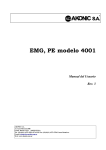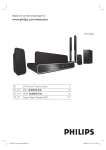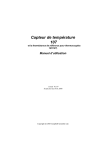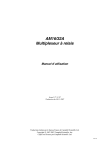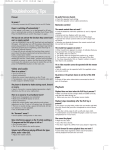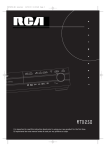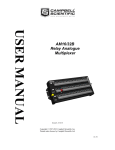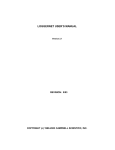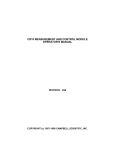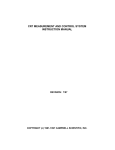Download Campbell CR7 Operator`s manual
Transcript
CR7 MEASUREMENT AND CONTROL SYSTEM OVERVIEW The CR7 Measurement and Control System combines precision measurement with processing and control capability in a battery operated system. Campbell Scientific, Inc. provides three documents to aid in understanding and operating the CR7: 1. This Overview 2. The CR7 Operator's Manual 3. The CR7 Prompt Sheet This Overview introduces the concepts required to take advantage of the CR7's capabilities. Hands-on programming examples start in Section OV4. Working with a CR7 will help the learning process, so don't just read the examples, turn on the CR7 and do them. If you want to start this minute, go ahead and try the examples, then come back and read the rest of the Overview. The sections of the Operator's Manual which should be read to complete a basic understanding of the CR7 operation are the Programming Sections 1-3, the portions of the data retrieval Sections 4 and 5 appropriate to the method(s) you are using (see OV5), and Section 14 which covers installation and maintenance. Section 6 covers the details of serial communications. Sections 7 and 8 contain programming examples. Sections 9-12 have detailed descriptions of the programming instructions, and Section 13 goes into detail on the CR7 measurement procedures. The Prompt Sheet is an abbreviated description of the programming instructions. Once familiar with the CR7, it is possible to program it using only the Prompt Sheet as a reference, consulting the manual if further detail is needed. Read the Selected Operating Details and Cautionary Notes at the front of the Manual before using the CR7. OV1. PHYSICAL DESCRIPTION The CR7 features a modular, multiple processor design that provides precision measurement and control capability in a rugged, battery operated system. Control Module functions include real-time task initiation, measurement processing, data storage, telecommunications, and keyboard/display interaction. The I/O Module performs all analog and pulse signal measurement functions as well as the analog and digital control output functions. The I/O Module contains its own processor card, a precision analog interface card, and seven card slots which can accommodate any combination of I/O Cards. Sensor leads are connected to the I/O cards via screw terminals. A maximum of four I/O modules, separated by up to 1,000 feet, may be connected to a single Control Module in applications that require distributed measurement capability. OV1.1 700X CONTROL MODULE Contains the CPU card, with 24K of system PROM and 40K of RAM; the serial interface card for peripheral communication and connection of up to four I/O Modules; and the keyboard display card. Two slots are present for optional RAM expansion. The system's 2.5 Ahr lead-acid batteries and AC charging circuitry are also contained in this module. The CS I/O 9-pin port provides connection to data storage peripherals, such as the SM192/716 Storage Module, and provides serial communication to computer or modem devices for data transfer or remote programming (Section 6). This 9 pin port does NOT have the same pin configuration as the OV-1 CR7 MEASUREMENT AND CONTROL SYSTEM OVERVIEW RS232 9 pin serial ports used on many computers. The SDM terminals adjacent to the serial port allow connection to Synchronous Device for Measurement (SDM) peripherals. These peripherals include the SDM-INT8 Interval Timer, the SDM-SW8A Switch Closure Module, the SDM-CD16AC AC/DC Controller, and the SDM-OBDII Engine Controller Interface. 709 512K MEMORY CARD: This card provides RAM storage for an additional 262,126 Final Data values. Only one 709 card may be installed. voltage with respect to the CR7 ground. Singleended channels are numbered sequentially, e.g., the HI and LOW sides of differential channels 2 are single-ended channels 3 and 4, respectively (Section 13.2). 724 PULSE COUNTER CARD: Provides 4 pulse counting channels for switch closures, low level AC cycles, or high frequency pulse signals. 725 EXCITATION CARD: There are 8 switched analog excitation channels. These supply programmable excitation voltages for resistive bridge measurements. The excitation channels are only switched on during the measurement. Only one is on at a time. OV1.2 720 I/O MODULE The processor card provides regulated power for analog and digital functions from the unregulated 12 volt supply. The analog interface card contains a 16-bit A/D-D/A converter, and a precision voltage reference. The standard I/O Module contains slots for 7 I/O Cards; the expanded Model 720XL contains 14 slots. All input and output connections to the I/O module are transient protected with spark gaps. The +12 volt and ground terminals provide a direct connection to the CR7 power supply. 723 ANALOG INPUT CARD: Contains 14 differential or 28 single ended inputs. Input ground terminals connect to a heavy copper bar, which reduces single ended measurement offsets to less than 5µV. 723-T ANALOG INPUT CARD WITH RTD: Identical to the 723 Card except that a platinum resistance thermometer is mounted in the center of the terminal strip. The PRT provides a reference junction temperature for thermocouple measurement. The PRT measurement is accurate to ±0.1oC over a range of -40oC to +60oC. The numbering on the terminals refers to the differential channels; i.e., the voltage on the HI input is measured with respect to the voltage on the Low input. When making single-ended measurements either the HI or the Low channel may be used independently to measure the OV-2 The two Continuous Analog Output (CAO) channels supply continuous output voltages, under program control, for use with strip charts, X-Y plotters, or proportional controllers. The 8 Digital Control Ports (0 or 5 volt states) allow on-off control of external devices. These control ports have a very limited current output (5mA) and are used to switch solid state devices which in turn provide power to relay coils (Section 14.4). 726 50 VOLT ANALOG INPUT CARD: Provides 8 differential or 16 single ended inputs for full scale DC ranges of ±50 V and ±15V. Resolution is 1.66 millivolts on the ±50 V and 0.5 millivolts on the ±15 V range. The common mode range is ±50 volts. OV1.3 ENCLOSURES AND CONNECTOR OPTIONS ENC-7L ALUMINUM FRAME FOR LABORATORY ENVIRONMENTS: 17" x 12" x 6"; provides a housing for benchtop use or a frame for attachment to a wall or a NEMA type enclosure. ENC-7F ENVIRONMENTALLY SEALED FIBERGLASS ENCLOSURE: 20" x 13" x 10"; housing for harsh environments. Sensor leads enter via two ports fitted with 0.75" conduit bushings, and plugged with removable stoppers. The 1.040" hole size accommodates #14 shell size circular connectors. CR 7 CR7 MEASUREMENT AND CONTROL SYSTEM OVERVIEW F LIE RE CA E LV VA UT PR UN IO N ON TT S BU RE SE FO CA G IN CK ES BE LO FIGURE OV1-1. CR7 Measurement and Control System OV2. MEMORY AND PROGRAMMING CONCEPTS The CR7 must be programmed before it will make any measurements. A program consists of a group of instructions entered into a program table. The program table is given an execution interval which determines how frequently that table is executed. When the table is executed, the instructions are executed in sequence from beginning to end. After executing the table, the CR7 waits the remainder of the execution interval and then executes the table again starting at the beginning. The interval at which the table is executed will generally determine the interval at which the sensors are measured. The interval at which data are stored is separate and may range from samples every execution interval to processed summaries output hourly, daily, or on longer or irregular intervals. Figure OV2-1 represents the measurement, processing, and data storage sequence in the CR7 and shows the types of instructions used to accomplish these tasks. OV2.1 INTERNAL MEMORY The CR7 has 40,960 bytes of Random Access Memory (RAM), divided into five areas. The five areas of RAM are: 1. Input Storage - Input Storage holds the results of measurements or calculations. The *6 Mode is used to view Input Storage locations to check current sensor readings or calculated values. Input Storage defaults to 28 locations. Additional locations can be assigned using the *A Mode. 2. Intermediate Storage - Certain Processing Instructions and most of the Output Processing Instructions maintain intermediate results in Intermediate Storage. Intermediate storage is automatically accessed by the Instructions and cannot be accessed by the user. The default allocation is 64 locations. The number of locations can be changed using the *A Mode. OV-3 CR7 MEASUREMENT AND CONTROL SYSTEM OVERVIEW ANALOG IPUTS SDM PORTS Input/Output Instructions 1. Volt (SE) 2. Volt (DIFF) 4. Ex-Del-Se 5. AC Half Br 6. Full Br 7. 3W Half Br 9. Full Br-Mex 11. Temp (107) 12. RH-(07) 13. Temp-TC SE 14. Temp-TC DIFF 17. Temp-Panel 101 102 103 104 113 115 118 CS I/O PORT SDM-INT8 SDM-SW8 SDM-AO4 SDM-CD16 SDM-SIO4 Set SDM Clock SDM-OBDII Telecommunications Program Control Instructions 96 (Storage Module, Printer) 97 Initiate Telecommunications 98 Print Character C1 700X CONTROL MODULE C3 I/O MODULE +12 720 C2 +12 MADE IN USA SDM CAMPBELL SCIENTIFIC INC. LOGAN, UTAH SERIAL I/O ANALOG INTERFACE 726 50 VOLT INPUT 1 H 2 H 3 H 1 H L 2 H L 3 H L 4 H L 5 H L 6 H L 7 H L 8 H L 1 CR7 4 MEASUREMENT & CONTROL SYSTEM 2 H 724 PULSE COUNTER I. D. RTD 1 H L 1 2 H L 2 3 H L 4 H L 5 H L SWITCHED ANALOG OUT 3 4 5 6 7 6 H L 8 1 7 H L 8 H L 9 H L 10 H L CONTINUOUS ANALOG OUT 2 11 H L 12 H L 13 H L 14 H L DIGITAL CONTROL OUT 1 2 3 4 5 6 7 8 725 EXCITATION DATA 3 4 ON 1 2 3 A 4 5 6 B 7 8 9 C * 0 # D AUX. POWER OFF MADE IN USA CONTROL PORTS PULSE INPUTS EXCITATION OUTPUTS CAO Input/Output Instructions 3. Pulse Input/Output Instructions 4. Ex-Del-Se 5. AC Half Br 6. Full Br 7. 3W Half Br 9. Full Br-Mex 11. Temp (107) 12. RH (207) 22. Excit-Del 21ANALOG OUT Input/Output Instructions 20 Set Port Program Control Instructions 83 If Case < F 86 Do 88 If x < = > y 89 If x < = > f 91 If flag, port 92 If Time Command Codes: 4x Set port x high 5x Set port x low 6x Toggle port x 7x Pulse port x FIGURE OV1-2. CR7 Wiring Panel and Associated Programming Instructions OV-4 CR7 MEASUREMENT AND CONTROL SYSTEM OVERVIEW INPUT/OUTPUT INSTRUCTIONS Specify the conversion of a sensor signal to a data value and store it in Input Storage. Programmable entries specify: (1) the measurement type (2) the number of channels to measure (3) the input voltage range (4) the Input Storage Location (5) the sensor calibration constants used to convert the sensor output to engineering units I/O Instructions also control analog outputs and digital control ports. INPUT STORAGE PROCESSING INSTRUCTIONS Holds the results of measurements or calculations in user specified locations. The value in a location is written over each time a new measurement or calculation stores data to the locations. Perform calculations with values in Input Storage. Results are returned to Input Storage. Arithmetic, transcendental and polynomial functions are included. OUTPUT PROCESSING INSTRUCTIONS INTERMEDIATE STORAGE Perform calculations over time on the values updated in Input Storage. Summaries for Final Storage are generated when a Program Control Instruction sets the Output Flag in response to time or events. Results may be redirected to Input Storage for further processing. Examples include sums, averages, max/min, standard deviation, histograms, etc. Provides temporary storage for intermediate calculations required by the OUTPUT PROCESSING INSTRUCTIONS; for example, sums, cross products, comparative values, etc. Output Flag set high FINAL STORAGE Final results from OUTPUT PROCESSING INSTRUCTIONS are stored here for on-line or interrogated transfer to external devices (Figure OV5.1-1). When memory is full, new data overwrites the oldest data. FIGURE OV2-1. Instruction Types and Storage Areas OV-5 CR7 MEASUREMENT AND CONTROL SYSTEM OVERVIEW 3. Final Storage - Final, processed values are stored here for transfer to printer, solid state Storage Module or for retrieval via telecommunication links. Values are stored in Final Storage only by the Output Processing Instructions and only when the Output Flag is set in the users program. The 18,336 locations allocated to Final Storage at power up is reduced if Input or Intermediate Storage is increased. 4. System Memory - used for overhead tasks such as compiling programs, transferring data, etc. The user cannot access this memory. 5. Program Memory - available for user programs entered in Program Tables 1 and 2, and Subroutine Table 3. (Sections OV3, 1.1) The use of the Input, Intermediate, and Final Storage in the measurement and data processing sequence is shown in Figure OV2-1. While the total size of these three areas remains constant, memory may be reallocated between the areas to accommodate different measurement and processing needs (*A Mode, Section 1.5). The size of system and program memory are fixed. OV2.2 CR7 INSTRUCTION TYPES Figure OV2.1 illustrates the use of the three different instruction types which act on data. The fourth type, Program Control, is used to control output times and vary program execution. Instructions are identified by numbers. 1. INPUT/OUTPUT INSTRUCTIONS (126,101-104, Section 9) control the terminal strip inputs and outputs (the sensor is the source, Figure OV1-2), storing the results in Input Storage (destination). Multiplier and offset parameters allow conversion of linear signals into engineering units. The Control Ports and Continuous Analog Outputs are also addressed with I/O Instructions. 2. PROCESSING INSTRUCTIONS (30-66, Section 10) perform numerical operations on values located in Input Storage (source) and store the results back in Input Storage (destination). These instructions can be used to develop high level algorithms to process measurements prior to Output Processing (Section 10). OV-6 3. OUTPUT PROCESSING INSTRUCTIONS (69-82, Section 11) are the only instructions which store data in Final Storage (destination). Input Storage (source) values are processed over time to obtain averages, maxima, minima, etc. There are two types of processing done by Output Instructions: Intermediate and Final. Intermediate processing normally takes place each time the instruction is executed. For example, when the Average Instruction is executed, it adds the values from the input locations being averaged to running totals in Intermediate Storage. It also keeps track of the number of samples. Final processing occurs only when the Output Flag is high. The Output Processing Instructions check the Output Flag. If the flag is high, final values are calculated and output. With the Average, accumulated totals are divided by the number of samples and the resulting averages sent to Final Storage. Intermediate locations are zeroed and the process starts over. The Output Flag, Flag 0, is set high by a Program Control Instruction which must precede the Output Processing Instructions in the user entered program. 4. PROGRAM CONTROL INSTRUCTIONS (85-98, Section 12) are used for logic decisions and conditional statements. They can set flags, compare values or times, execute loops, call subroutines, conditionally execute portions of the program, etc. OV2.3 PROGRAM TABLES AND THE EXECUTION AND OUTPUT INTERVALS Programs are entered in Tables 1 and 2. Subroutines, called from Tables 1 and 2, are entered in Subroutine Table 3. The size of each table is flexible, limited only by the total amount of program memory. If Table 1 is the only table programmed, the entire program memory is available for Table 1. Table 1 and Table 2 have independent execution intervals, entered in units of seconds with an allowable range of 0.0125 to 6553 seconds. Intervals shorter than 0.1 seconds are allowed only in Table 1. Subroutine Table 3 has no execution interval; subroutines are only executed when called from Table 1 or 2. CR7 MEASUREMENT AND CONTROL SYSTEM OVERVIEW Table 1. Execute every x sec. 0.0125 < x < 6553 Table 2. Execute every y sec. 0.1 < y < 6553 Table 3. Subroutines Instructions are executed sequentially in the order they are entered in the table. One complete pass through the table is made each execution interval unless program control instructions are used to loop or branch execution. Table 2 is used if there is a need to measure and process data on a separate interval from that in Table 1. A subroutine is executed only when called from Table 1 or 2. Normal Order: MEASURE PROCESS CHECK OUTPUT COND. OUTPUT PROCESSING Subroutine Label Instructions End Subroutine Label Instructions End Subroutine Label Instructions End FIGURE OV2-2. Program and Subroutine Tables OV2.3.1 THE EXECUTION INTERVAL OV2.3.2 THE OUTPUT INTERVAL The execution interval specifies how often the program in the table is executed, which is usually determined by how often the sensors are to be measured. Unless two different measurement rates are needed, use only one table. A program table is executed sequentially starting with the first instruction in the table and proceeding to the end of the table. The interval at which output occurs is independent from the execution interval, other than the fact that it must occur when the table is executed (i.e., a table cannot have a 10 minute execution interval and output every 15 minutes). Each instruction in the table requires a finite time to execute. If the execution interval is less than the time required to process the table, the CR7 overruns the execution interval, finishes processing the table and waits for the next execution interval before initiating the table. When an overrun occurs, decimal points are shown on either side of the G on the display in the LOG mode (*0). Overruns and table priority are discussed in Section 1.1. A single program table can have many different output intervals and conditions, each with a unique data set (output array). Program Control Instructions are used to set the Output Flag which determines when output occurs. The Output Processing Instructions which follow the instruction setting the Output Flag determine the data output and its sequence. Each additional output array is created by another Program Control Instruction setting the Output Flag high in response to an output condition, followed by Output Processing Instructions defining the data set to output. OV3. PROGRAMMING THE CR7 A program is created by keying it directly into the datalogger or on a PC using the PC208 or PC208W Datalogger Support Software program EDLOG. This manual describes direct interaction with the CR7. Work through the direct programming examples in this overview before using EDLOG and you will have the basics of CR7 operation as well as an appreciation for the help provided by the software. Section OV3.5 describes options for loading the program into the CR7. OV-7 CR7 MEASUREMENT AND CONTROL SYSTEM OVERVIEW OV3.1 FUNCTIONAL MODES User interaction with the CR7 is broken into different functional MODES, (e.g., programming the measurements and output, setting time, manually initiating a block data transfer to Storage Module, etc.). The modes are referred to as Star (*) Modes since they are accessed by first keying *, then the mode number or letter. Table OV3.1 lists the CR7 Modes. TABLE OV3-1. * Mode Summary Key Mode *0 *1 *2 *3 *4 *5 *6 LOG data and indicate active Tables Program Table 1 Program Table 2 Program Table 3, subroutines only Enable/disable printer output Display/set real time clock Display/alter Input Storage data, toggle flags Display Final Storage data Final Storage data transfer to cassette tape Final Storage data transfer to printer Memory allocation/reset Signature test/PROM version Security Save/load Program TABLE OV3-2. Key Description/Editing Functions Key Action 0-9 * A B C Key numeric entries into display Enter Mode (followed by Mode Number) Enter/Advance Back up Change the sign of a number or index an input location to loop counter Enter the decimal point Clear the rightmost digit keyed into the display Advance to next instruction in program table (*1, *2, *3) or to next output array in Final Storage (*7) Back up to previous instruction in program table or to previous output array in Final Storage Delete entire instruction D # #A *7 *8 *9 *A *B *C *D OV3.2 KEY DEFINITION Keys and key sequences have specific functions when using the CR7 keyboard or a terminal/computer in the remote keyboard state (Section 5). Table OV3.2 lists these functions. In some cases, the exact action of a key depends on the mode the CR7 is in and is described with the mode in the manual. #B #D OV3.3 PROGRAMMING SEQUENCE In routine applications, sensor signals are measured, processed over some time interval, and the results are stored in Final Storage. A generalized programming sequence is: 1. Enter the execution interval, determined by the desired sensor scan rate. 2. Enter the Input/Output Instructions required to measure the sensors. 3. Enter any Processing Instructions required to get the data ready for Output Processing. 4. Enter a Program Control Instruction to test the output condition and Set the Output Flag when the condition is met. For example, use Instruction 92 to output based on time, 86 to output each time the table is executed, and 88 or 89 to compare input values. This instruction must precede the Output Processing Instructions. 5. Enter the Output Processing Instructions to store processed data in Final Storage. The order in which the data are stored is determined by the order of the Output Processing Instructions in the table. 6. Repeat steps 4 and 5 for output on different intervals or conditions. OV-8 CR7 MEASUREMENT AND CONTROL SYSTEM OVERVIEW OV3.4 INSTRUCTION FORMAT Instructions are identified by an instruction number. Each instruction has a number of parameters that give the CR7 the information it needs to execute the instruction. The CR7 Prompt Sheet has the instruction numbers in red, with the parameters briefly listed in columns following the description. Some parameters are footnoted with further description under the "Instruction Option Codes" heading. For example, Instruction 73 stores the maximum value that occurred in an Input Storage Location over the output interval. The instruction has three parameters (1) REPetitionS, the number of sequential Input Storage locations on which to find maxima, (2) TIME, an option of storing the time of occurrence with the maximum value, and (3) LOC the first Input Storage Location operated on by the Maximum Instruction. The codes for the TIME parameter are listed in the "Instruction Option Codes". The repetitions parameter specifies how many times an instruction's function is to be repeated. For example, four 107 thermistor probes, wired to single-ended channels 1 through 4, are measured using a single Instruction 11, Temp107, with four repetitions. Parameter 2 specifies the input channel of the first thermistor (channel 1) and parameter 4 specifies the Input Storage Location in which to store measurements from the first thermistor. If Location 5 were used, the temperature of the thermistor on channel 1 would be stored in Input Location 5, the temperature from channel 2 in Input Location 6, etc. Detailed descriptions of the instructions are given in Sections 9-12. OV3.5 ENTERING A PROGRAM Programs are entered into the CR7 in one of four ways: b. Stored/loaded from SM192/716 Storage Module 3. Loaded from Storage Module or internal PROM (special software) upon power-up. A program is created by keying it directly into the datalogger as described in the following Section, or on a PC using the PC208 Datalogger Support Software. PC208 Software programs are used to develop and send programs to the CR7. Program files developed can be downloaded directly to the CR7 via direct wire, telephone, or Radio Frequency (RF). Programs on disk can be copied to a Storage Module. Using the *D Mode to save or load a program from a Storage Module is described in Section 1.8. If the SM192/716 Storage Module is connected when the CR7 is powered-up, the CR7 will automatically load program number 8, provided that a program 8 is loaded in the Storage Module (Section 1.8). It is also possible (with special software) to create a PROM (Programmable Read Only Memory) that contains a datalogger program. With this PROM installed in the datalogger, the program will automatically be loaded and run when the datalogger is powered-up, requiring only that the clock be set. OV4. PROGRAMMING EXAMPLE The best way to become acquainted with the CR7 is to program it and make some measurements. If your CR7 contains either a 723 or 723-T Analog Input card, a short copper-constantan thermocouple (TC) should be connected to channel 5. In this example, you will program the CR7 to sample the thermocouple temperature. If you have not purchased the 723-T with a Resistive Temperature Device (RTD) to measure the TC reference junction temperature, a "dummy" reference temperature will be used. 1. Keyed in using the CR7 keyboard. 2. Loaded from a pre-recorded listing using the *D Mode. There are two types of storage/input: a. Stored on disk/sent from computer (PC208 software). OV-9 CR7 MEASUREMENT AND CONTROL SYSTEM OVERVIEW Tables OV3-1 and OV3-2 summarize the Keyboard Commands and Control Modes used to program the CR7, monitor Input and Final Storage and control data output to peripherals. The instructions, and their associated parameters, are the CR7's programming steps and are used to build the CR7's program. It is not necessary to understand all the commands to proceed with this programming exercise. It is helpful to find the example's instructions on the CR7 Prompt Sheet provided with this manual. As you become familiar with programming the CR7, you will find that the Prompt Sheet or the PC208 program EDLOG has all the information you need to write your program. By following along on the Prompt Sheet as you proceed with this exercise, you will learn how to use it to write your own programs. OV4.1 MEASUREMENT To make a thermocouple temperature measurement, the CR7 must know the temperature of the reference junction. The CR7 takes the reference temperature, converts it to the equivalent TC voltage, adds the measured TC voltage and converts the sum to temperature through a polynomial fit to the TC output curve. In this example, the reference junction is at the Analog Input Card. Its temperature is measured with Instruction 17, Panel Temperature. If you have an Analog Input Card with RTD, check to see which number is assigned to it. A tag labeled RTD is on the left hand side and the card number is on the right hand side of the Analog Input Card. If the RTD card is not card 1, you must enter the correct card number as Parameter 1 of Instruction 17. If you do not have an Analog Input Card with RTD, you will omit Instruction 17 from the Program and enter a "dummy" reference temperature after the Program is compiled. The thermocouple temperature measurement is made using Instruction 14 (differential voltage measurement of TC) on differential channel 5. When using a copper-constantan thermocouple, the copper lead is connected to the high input of a differential channel and the constantan lead is connected to the low side. The channel numbering printed on the Analog Input Cards refers only to differential channels. OV-10 Either the high or low side of a differential channel may be used for single ended measurements. (Each side is counted when assigning single ended channel numbers; e.g., the high side of differential channel 8 is single ended channel 15 and the low side is single ended channel 16). The first parameter in Instruction 14 is the number of times to repeat the measurement: 1 is entered because only one thermocouple is measured. If more thermocouple measurements were desired, the copper leads would be connected to the high sides of consecutive differential channels, the constantan leads to the low sides and the number of repetitions entered in Parameter 1 would equal the number of thermocouples. Parameter 2 is the voltage range to use when making the measurement. The output of a copper-constantan thermocouple is approximately 40 microvolts per oC difference in temperature between the two junctions. The +5000 uV scale will provide a range of +5000/40 = +125 oC (i.e., this scale will not overrange as long as the measuring junction is within 125 oC of the panel temperature). The resolution of the +5000 uV range is 166 nV or 0.004 oC. Parameter 3 is the Input Card number and Parameter 4 is the channel on which to make the first measurement. If more than one thermocouple is measured, the CR7 will automatically advance through the channels and on to the next card if necessary. Similarly, Parameter 7 is the Input Storage Location in which to store the first measurement; e.g., if there are five repetitions and the first measurement is stored in location 3, the final measurement will be stored in location 7. Parameter 6 is the Input Storage location in which the reference temperature is stored, and Parameters 8 and 9 are the multiplier and offset to apply to the temperature value. A multiplier of 1 and an offset of 0 give the result in oC, a multiplier of 1.8 and an offset of 32 give the result in oF. Now that you have some idea of what you are telling the CR7 by entering the parameters, we will proceed with programming the CR7. CR7 MEASUREMENT AND CONTROL SYSTEM OVERVIEW TABLE OV4-1. Thermocouple Measurement Programming Example TURN ON THE POWER SWITCH AND PROCEED AS FOLLOWS: Display ID:Data Key HELLO 01 Display ID:Data Key :0064 * 00:00 1 01:00 A 01:0.0000 2 01:2 A Description The number after "HELLO" will count up as memory is checked. If you have a 512K Memory Card, this can take a long time; key # to abort the test. The result of the CPU board memory check is then displayed (Sect. 1.5) Enter Program Table 1, advance to Execution Interval Enter 2 second Execution Interval advance to first instruction -------Users without RTD omit next Instruction-----01:P00 01:00 17 1 02:0000 1 01:P17 01:1 A A 02:1 A Measure Panel Temp., advance to first Parameter RTD in input card #1, if RTD card other than #1, enter correct card # Store temp in location 1 -------Users without RTD continue here------Instruction Location Number will be 1 less (i.e., 01:P00) 02:P00 01:00 02:00 03:00 04:00 05:00 06:0000 07:0000 08: 0.0000 09: 0.0000 14 1 2 1 5 1 1 2 1 02:P14 01:1 02:2 03:1 04:5 05:1 06:1 07:2 08:1 09:0.0000 03:P00 00:00 A A A A A A A A A A * 0 :LOG 1 TC temp., differential meas. 1 repetition Range code (5000uV, slow) Input card #1 Input channel of 1st TC TC type (copper-constantan) Reference temp. is in location 1 Store TC temp. in location 2 Multiplier of 1 No offset entered (offset=0), advance to next instruction Exit Table 1 Enter *0 Mode, compile table The CR7 is now programmed to measure the thermocouple temperature and to store the result in Input Storage Location 2. The colon between the ID and Data fields blinks each time Table 1 is executed, every 2 seconds in this example. If you do not have an RTD, the "reference temperature" is 0.0 and the value stored in Location 2 is the difference in temperature between the panel and the thermocouple. The *6 Mode can be used to monitor the values in the Input Storage and to change the value of the dummy reference temperature. OV-11 CR7 MEASUREMENT AND CONTROL SYSTEM OVERVIEW TABLE OV4-2. Using *6 Mode to Observe Example TC Measurements (User with Model 723-T RTD Card) Display ID:Data Key :LOG 1 *6 00:00 0 Display ID:Data 06:0000 01:21.234 02:22.433 01:21.199 :LOG 1 Key A A B * Description Enter *6 Mode, advance to first location Panel temp is 21.234 oC, advance to location 2 TC temp is 22.433 oC, backup to location 1 Panel temp is now 21.199 oC Return to *0 Mode TABLE OV4-3. Using *6 Mode to Observe Example TC Measurements (User with Model 723 Card, No RTD) Display ID:Data Key :LOG 1 *6 :0.0000 20 00:00 0 Display ID:Data 06:0000 01:0.0000 02:2.9533 01:0.0000 :20 01:20.000 02:22.866 Key A A B C A A * :LOG 1 You can advance through Input Storage by keying in the advance command, A, or backup by keying in the backup command, B. The Input Location you are observing is shown on the left in the display ID field. The temperature data stored in the Input locations are updated every 2 seconds, each time Table 1 is executed. Verify this by changing the temperature of the thermocouple (hold it in your fingers) while monitoring the proper Input Location. OV-12 Description Enter *6 Mode, advance to first location Reference temp is 0.0oC, advance to location 2 TC "temp" is 2.9533 C, backup to location 1 Setup to change stored value Store 20 in location 1 Advance to location 2 The TC temp in location 2 using a reference temperature of 20o Return to *0 Mode It is possible to go directly to a specific Input Storage location by entering the *6 Mode and keying in the desired location before keying A. A similar utility is available in other Modes. OV4.2 OUTPUT In the following example instructions are appended to Table 1 to output the time and the average temperatures to Final Storage every 5 minutes. CR7 MEASUREMENT AND CONTROL SYSTEM OVERVIEW TABLE OV4-4. Example Programming to Obtain Five Minute Averages Display ID:Data Key Display ID:Data 1 3 : LOG 1 01:00 01:3 A 03:P00 01:0000 02:0000 03:00 92 0 5 10 03:P92 01:0 02:5 03:10 A A A A Enter If Time Instruction Enter 0 minutes into interval Enter 5 minute time interval Set output Flag 0 04:P00 01:0000 05:P00 01:00 02:0000 77 10 71 2 1 04:P77 :10 05:P71 01:2 02:1 A A A A A Enter Output Time Instruction Code for HR:MIN Enter Average Instruction 2 repetitions Location of 1st input data to be averaged * Exit Table 1 Enter *5 Mode to set clock (the clock will be running) Enter Year Enter Julian day (January 11 assumed in this example) Enter Hours:Minutes (24 hour time, 1:24 PM assumed in this example) Exit *5 Mode, compile Table 1, commence logging data 00:00 01:00 06:P00 Key * 00:00 05:00 05:0000 5 85 11 :00:21:32 05:85 05:11 A A A 05:00:21 1324 05:13:24 A 13:24:01 Description *0 Program Table 1 Advance to 3rd Instruction location (Key in 2 if Instruction 17 was not entered, Instruction Location Number will be 1 less than shown in table) : LOG 1 The CR7 is now programmed to sample the panel and thermocouple temperatures every 2 seconds and to output the time and the average temperatures to Final Storage every 5 minutes. Each Output Array sent to Final Storage will consist of 4 data values. The first value will be an output identifier which gives the number of the Table which caused the output, and the instruction location number of the instruction which set the output flag. The second value will be the time, and the third and fourth values will be the average temperatures of the I/O Module and the thermocouple. Values stored in Final Storage can be viewed using the *7 Mode. Table 1.2-5 shows an example of the use of the *7 Mode, it is assumed that the CR7 has been logging data for 8 minutes since the time was set in the previous example. OV-13 CR7 MEASUREMENT AND CONTROL SYSTEM OVERVIEW TABLE OV4-5. Using *7 Mode to View Values in Final Storage Display ID:Data Key Display ID:Data :LOG 1 00:00 Key Description * 7 07:9.0000 A 01:0103. A 02:1325. 03:22.57 04:23.43 01:0103. 02:1330. 03:22.61 00:00 A A A A A * 0 :LOG 1 Enter *7 Mode. The DSP is at Final Storage location 9, advance to first data value Output identifier: users who did not enter Instruction 17 will see 01: 0102 because the output flag is set by the second instruction in Table 1 Time Average panel temp for readings between 1:24 and 1:25 P.M. Average thermocouple temp. Output identifier Time Average panel temp for readings between 1:25 and 1:30 P.M. Enter *0 Mode OV4.3 EDITING AN EXISTING PROGRAM When editing an existing program in the CR7, entering a new instruction inserts the instruction; entering a new value for an instruction parameter replaces the previous value. To insert an instruction, enter the program table and advance to the position where the instruction is to be inserted (i.e., P in the data portion of the display), key in the instruction number, and then key A. The new instruction will be inserted at that point in the table, advance through and enter the parameters. The Instruction that was at that point and all instructions following it will be pushed down to follow the inserted instruction. An instruction is deleted by advancing to the instruction number (P in display) and keying #D (Table OV3-2). To change the value entered for a parameter, advance to parameter and key in the correct value then key A. Note that the new value is not entered until A is keyed. TABLE OV4-6. EDLOG Listing of Example Program * 01: 1 2 Table 1 Programs Sec. Execution Interval 01: 01: 02: P17 1 1 Panel Temperature IN Card Loc : 02: 01: 02: 03: 04: 05: 06: 07: 08: 09: P14 1 2 1 5 1 1 2 1 0 Thermocouple Temp (DIFF) Rep 5000 uV slow Range IN Card IN Chan Type T (Copper-Constantan) Ref Temp Loc Loc [:TC Temp ] Mult Offset 03: 01: 02: 03: P92 0 5 10 If time is minutes into a minute interval Set high Flag 0 (output) 04: 01: P77 10 Real Time Hour-Minute 05: 01: 02: P71 2 1 Average Reps Loc OV4.4 EDLOG PROGRAM LISTING The examples in the rest of this manual use program listings generated by EDLOG, the datalogger Program Editor for the PC (PC208(W) Software). The EDLOG listing does not show the CR7 display or the "A" keystrokes used to enter data. The EDLOG listing for the previous example is given in Table OV4-6. OV-14 CR7 MEASUREMENT AND CONTROL SYSTEM OVERVIEW OV5. DATA RETRIEVAL OPTIONS There are several options for data storage and retrieval. These options are covered in detail in Sections 2, 4, and 5. Figure OV5-1 summarizes the various possible methods. Regardless of the method used, there are three general approaches to retrieving data from a datalogger. 1. On-line output of Final Storage data to a peripheral storage device. On a regular schedule, that storage device is brought back to the office/lab where the data is transferred to the computer. Another storage device is usually taken into the field and exchanged for the one which is retrieved so that data collection can continue uninterrupted. 2. Bring a storage device to the datalogger and transfer all the data that has accumulated in Final Storage since the last visit. 3. Retrieve the data over some form of telecommunications link, that is, Radio Frequency (RF), telephone, short haul modem, multi-drop interface, or satellite. The PC208 software automates this process. Regardless of which method is used, the retrieval of data from the datalogger does NOT erase those data from Final Storage. The data remain in the ring memory until: • they are written over by new data (Section 2.1) • memory is reallocated (Section 1.5) • the power to the datalogger is turned off. Table OV5-1 lists the instructions used with the various methods of data retrieval. TABLE OV5-1. Data Retrieval Methods and Related Instructions Storage Module Printer, other Serial Device Telecommunications (RF, Phone, Short Haul, SC32A) Inst. 96, *4 *9 *D Inst. 96, 98 *4 *9 *D Inst. 97 (Telecommunications Commands) TABLE OV5-2. Data Retrieval Sections in Manual Topic Instr. 96 Instr. 97 *4 *8 *9 *D Storage Module Telecommunications Section in Manual 4.1, 12 12 4.1 4.2 4.2 1.8 4.3 5 OV-15 CR7 MEASUREMENT AND CONTROL SYSTEM OVERVIEW +12 720 I/O MODULE 700X CONTROL MODULE MADE IN USA CAMPBELL SCIENTIFIC INC. LOGAN, UTAH SERIAL I/O ANALOG INTERFACE 6 H L 7 H L 8 H L 1 2 3 4 5 6 7 8 9 H L H L H L H L H L H L H L H L H L 10 H L 11 H L 726 50 VOLT INPUT 1 H 2 H 3 H 1 H L 2 H L 3 H L 4 H L 5 H L 1 CR7 4 MEASUREMENT & CONTROL SYSTEM 2 H 724 PULSE COUNTER I. D. RTD 1 2 SWITCHED ANALOG OUT 3 4 5 6 7 13 H L 14 H L 4 725 EXCITATION ON OFF Display Storage Module Card Storage Module DATA 3 DIGITAL CONTROL OUT 1 2 3 4 5 6 7 8 CONTINUOUS ANALOG OUT 1 2 8 12 H L Multidrop Modem 1 2 3 A 4 5 6 B 7 8 9 C * 0 # D AUX. POWER MADE IN USA Shorthaul Modem RF Modem Phone Modem Satellite Interface Phone Modem Satellite Ground Station Transceiver Storage Module Card Storage Module RS-232 Interface RS-232 Interface Direct RS-232 Interface Multidrop Modem Shorthaul Modem RS-232 Interface Logger Time 00:03:54 Flags Ports H=Help Transceiver RF Base Station V = View save to file F1. . F8 = Toggle flags P1. . P6 = Toggle ports C = Collect data G = Graph enter/exit R = Re-scale + = Incr. auto exponent - = Decr. auto exponent 1: SOLAR 2: TEMP C 3: RH % 2300 2200 2100 2000 1900 1800 900 800 700 1700 1600 1500 600 500 400 1400 1300 300 200 1200 1100 1000 100 Scale = Auto FIGURE OV5-1. Data Retrieval Hardware Options OV-16 CR7 MEASUREMENT AND CONTROL SYSTEM OVERVIEW OV6. SPECIFICATIONS Electrical specifications are valid for over a -25° to +50°C range unless otherwise specified. Analog Inputs (723T or 723 Card specifications below; 726 ±50 V Card specifications discussed in System Description) Voltage Measurement Types: Single-ended or differential. Range and Resolution: Ranges are software selectable on any input channel. Full Scale Resolution Input Range (mV) Differential Single-ended ±5000 166 µV 333 µV ±1500 50 µV 100 µV ±500 16.6 µV 33.3 µV ±150 5 µV 10 µV ±50 1.66 µV 3.33 µV ±15 500 nV 1000 nV ±5 166 nV 333 nV ±1.5 50 nV 100 nV Accuracy of Voltage Measurements: Differential: ±0.02% FSR (±0.01%, 0-40°C) (e.g. ±0.02% FSR = ±2.0 mV for ±5 V range) Positive single-ended: ±0.02% FSR (±0.01%, 0-40°C) ±5 µV Negative single-ended: ±0.03% FSR (±0.015%, 0-40°C) ±5 µV High Frequency Pulse Mode Minimum Pulse Width: 2 µs Maximum Input Frequency: 250 kHz Voltage Thresholds: The count is incremented when the input voltage changes from below 1.5 V to above 3.5 V. Maximum Input Voltage: ±20 V Low Level AC Mode This mode is used for counting the frequency of low voltage, sine wave signals. Input Hysteresis: 11 mV Maximum AC Input Voltage (RMS): 20 V Frequency Range: Minimum AC Input Voltage (mV RMS) 15 25 50 160 Range (Hz) 1 1 1 1 to to to to 100 1,000 3,000 10,000 Digital Control Outputs (725 Card) Each card includes 8 digital control outputs. Transient Protection All input and output connections to the I/O Module are protected using spark gaps that are rated to 10,000 A. The spark gaps are connected directly to a heavy copper bar on each input card with no more than 2 inches of 20 AWG copper wire. Control Module Processor: Hitachi 6303 Memory: 24K ROM; 40K RAM, 709 Card provides an additional 512K RAM. Data Storage: 18.8K values, standard; 280K values, expanded. Display: 8 digit LCD (0.5” digits). Peripheral Interface: 9-pin, D-type connector on the Control Module panel for connection to storage module, card storage module, multidrop interface, modem, printer, or RS-232 adapter. Baud rates selectable at 300, 1200, 9600, and 76,800. Output Voltages (no load): High: 5.0 V ±0.1 V Low: < 0.1 V I/O Module Interface: Optically isolated current loops allow connection of up to 4 I/O Modules. I/O Modules can be separated from the Control Module by up to 1,000 feet. Output Resistance: 400 Ω Clock Accuracy: ±1 minute per month. Analog Outputs (725 Card) Maximum Program Execution Rate: System tasks can be initiated in sync with real-time up to 80 Hz. Each card contains 8 switched and 2 continuous analog outputs. System Power Requirements Switched: Provides a precision voltage for resistance measurement, then switches off (high impedance). Only one switched output can be active at a time. Voltage: 9.6 to 15 VDC Internal Batteries: Sealed rechargeable with 2.5 Ahr capacity per charge. Common Mode Range: ±5 V Continuous: A preset voltage is held until updated. Voltage degrades 0.17 mV every 7 seconds. All continuous analog outputs (and digital control ports) can be active simultaneously. Common Mode Rejection: > 140 dB (DC to 100 Hz) Range: ±5 V Normal Mode Rejection: 70 dB (60 Hz with slow differential measurement) Accuracy: Same as voltage measurements. Input Current: 100 pA max Output Current: 25 mA at ±5 V, 50 mA at ±2 V Input Sample Rates: Fast A/D conversions are integrated over 250 µs. Slow A/D conversions are integrated over 16.67 ms for 60 Hz AC rejection or optionally, 20.0 ms for 50 Hz AC rejection. Differential measurements include two conversions, one with reversed input polarity, to reduce thermal offset and common mode errors. The following intervals do not include the self-calibration measurement which occurs once per instruction. Input sample Typical input rates noise ms/channel nV/RMS Fast Single-ended 2.9 350 Fast Differential 4.7 250 Slow Single-ended 22.0 43 Slow Differential 43.0 30 Fast Differential (TC) 7.9 250 Input Current Noise: 9 pA RMS (slow differential) Input Resistance: 2.5 GΩ typical Sustained Input Voltage without Damage: ≤ ±16 VDC Pulse Counters (724 Card) Pulse Counters per Card: 4 Maximum Counts per Interval: 32,767 (with overrange detection) Modes: Programmable modes are switch closure, high frequency pulse, and low level AC. Switch Closure Mode Minimum Switch Closed Time: 1 ms Minimum Switch Open Time: 4 ms Maximum Bounce Time: 1.4 ms open without being counted. Resolution: 166 µV Resistance and Conductivity Measurements (Combination of 723 and 725 Cards) Accuracy: ±0.01% of full scale bridge output provided the matching bridge resistors are not the limiting factor. Measurement Types: 6-wire and 4-wire full bridge, 4-wire, 3-wire, and 2-wire half bridges. High accuracy, low impedance bridge measurements are made ratiometrically with dual polarity measurements of excitation and output to eliminate thermal emfs. AC resistance and conductivity measurements use a 750 µs excitation pulse with the signal integration occurring over the last 250 µs. An equal duration pulse of opposite polarity is applied for ionic depolarization. Typical Current Drain: 3.5 - 6 mA (minimum system) quiescent, 16 mA during processing, 100 mA during analog measurement. Charging Circuit: Requires DC or rectified AC voltage from 15 to 25 V. Thermal compensation is included to optimize charging voltage according to ambient temperature. External Batteries: Any 12 V external battery can be a primary power source; internal batteries provide a backup while the external batteries are changed. Operation from AC Sources: An AC operated battery charger is included with the enclosure to maintain full charge on the batteries where AC power is available. In the event of power failure, the internal batteries will keep the system operational for up to 5 days in most applications. Physical Specifications Size: ENC 7L ENC 7F ENC 7XL 17” x 12” x 6” 20” x 13” x 10” 19” x 19” x 10” Weight: ~40 lbs (ENC 7F with 700X, 720, & seven I/O cards). Warranty Three years against defects in materials and workmanship. OV-17

















